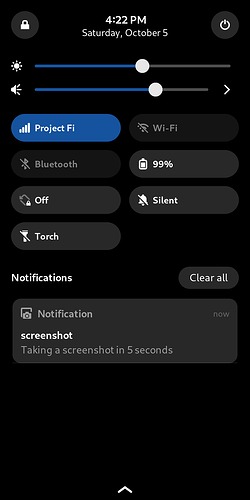I wrote about it elsewhere on the forums, but what I do with my L5 is this:
- buy a bunch of extra L5 batteries from Purism
- buy a bunch of cheap $10 Kastar universal chargers from online shopping, compatible with those batteries
- buy a 3D print of the librem5 backplate that is more easily removable and doesnt tear after months of removing it daily (from some online 3D print fabricator, using the public/open Librem 5 designs from Putism)
After doing this, I have infinite battery. All the Androids are put to shame and I never have to charge my phone; instead I do a battery rotation process:
- connect Librem 5 to charger
- remove backplate
- remove L5 battery while device is still on
- unplug cheap universal charger
- remove battery from charger
- place charged battery from charger quickly in L5 (battery % in corner of screen shows low or half)
- unplug L5 from power (L5 battery then jumps to showing actual %, which is now 90% again or whatever)
- place old L5 battery on charger for later
The charges will charge more slowly than the L5 does on the same battery, probably to prevent any heat or issues. But if I have many chargers going in this way and rotate which one to use, I have infinite L5 energy as long as I switch every so often.
For me local time it is 4 PM. I am in an airport terminal writing this. In the morning I put in the current battery probably at 10am or so. Now that it’s been 5 hrs, I’m reaching 40% power, so that’s probably a good time for another battery swap.
But I have pseudo infinite L5 energy on my trip because it’s only about 9 or 10 hours until I get to where I’m going, and I have 4 more batteries which probably each have another 5 hours in them, or slightly less if I use the phone more - but it’s generally way overshot. Maybe in the airport I will battery swap without a wall adapter, which requires turning my phone off to take out the battery, but that’s fine for my use case.
For my cellular provider, I am riding the coattails of my life as a former Android user. My SIM card is from Google Fi, and was registered with some dead Android phone, and they still think that other phone is what I’m using so they let me data and text as much as I want on here on the L5. MMS is not working, so I have a browser cookie on the L5 that can pull up the Google Messages for Web, which has a duplicate of all my texts and messages, so I can do calling and texting from any (javascript enabled) browser. In practice, for a better calling experience, I usually make important calls with a laptop.
For me these together solve most of my issues, so I am going around with basically stock Byzantium as my phone. I masked the avahi service(s) because for my use cases its a waste of energy to always tell nearby devices on wifi about my device. I also disabled wifi mode in geoclue, which based on my rough estimation of trying to monitor we traffic, might have disabled the L5 from otherwise uploading the name of all nearby wifi access points and cell towers coupled with my device IP to an online service, sometimes as frequently as maybe every 5 seconds, at the discretion of geoclue which is installed (by 3 letter agencies?) on all linux distros by default or whatever. Of course, disabling this technology means my device may have a much poorer understanding of where I am on a map, because I would be constrained to 25 year-old one-way incoming GPS to determine where I am on a map, whereas for Android and iOS the location they provide can be much more accurate because it is two-way, sending identifiers of the device to the online service that sends back where you are using a singular understanding of the location of all devices, instead of GPS triangulation.
So, my intuition is that disabling that part of geoclue might save me some battery. I have frequented the same places often enough, and been a passenger in other cars often enough, that I did not myself bother to use my Librem 5 for maps and navigation almost at all.
But also, the “wifi” based two-way online service to find your location “better than GPS” was also shut down after some people talked about it on purism forums and listed how to disable it. So, what happens in your newer phosh? Is it off by default? Submitting all your personal info to a dead endpoint every 5 sec? I have no idea.
A lot of things like avahi that I personally decided are dumb for my uses, and that I turned off, are findable by using basic networking software tools for Linux to ask our device what it is doing, like ss or netstat or tcpdump or wireshark.
